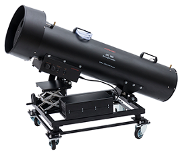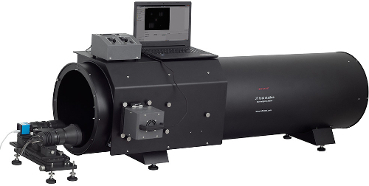Boresight systems
Boresight is a process to align optical axis of single system or a series of optical or electro-optical systems with a certain reference optical axis or mechanical axis. It is typically required to achieve situation when all the axis are parallel. Quality of boresigh of EO imaging/laser systems is presented in form of a series of boresight errors understood as angles between optical/mechanical axis. Number of boresight errors vary from several errors for case of single-sensor imagers to over a dozen in case of multi-sensor imaging/laser systems (see Educational section).

Characterization of EO imaging/laser systems without some information on boresight errors is not complete. Therefore practically every test system offered by Inframet to test thermal imagers, night vision devices, VIS/NIR cameras, SWIR cameras, laser range finders, laser pointers, UV cameras, optical sights, or multi-sensor systems (DT, TAIM, DTR, TCLIP, SIM, NVS, NVT, NV14, NIMAX, NICOM, NCLIP, TVT, VINIS, ST, SINIS, LTE, LTR, LUNI, MS, MIM,OPO) offers some ability to measure or at least checking some boresight errors. However, boresight is only a secondary task for test system listed earlier - the main task is measurement of performance parameters. This section presents several stations developed for boresight of multi-sensor imaging/laser systems that are typically considered as the most difficult case for boresight and proper boresight is critical for optimal performance. It should be noted that boresight stations presented in this section are only a small fraction of systems that can be potentially used for boresight of different EO imaging/laser systems.
Inframet offers four stations (JT, JIMS , JAT and JTAR) developed specifically for boresight of multi-sensor EO systems. Basic tests of multi-sensor systems is an optional task. The main drawback of JT/JIMS systems is dead central area of the on axis collimator. If it is not acceptable then MS or MIM systems are recommended.
|
Fig. 1. JT400 boresight station |
|
|
Fig. 2. JIMS boresight station |
|
|
|
|
 Fig. 3. JAT200 mobile boresight station |
 Fig. 4. JTAR portable boresight station |
JT stations are modular, quasi-universal systems that enable expanded boresight and basic tests of multi-sensor E-O systems based on big on axis collimators (typically up to 600mm aperture). In special cases systems of aperture up to 800mm can be delivered. Because of use of a single collimator of large aperture covering optics of all imaging/laser sensors highest boresight accuracy can be achieved.
JIMS boresight stations can be treated as a special budget version of JT station optimized for testing EO systems of ultra large aperture (over 400mm). Special optical expander is used to increase effective aperture of a typical reflective on axis collimator of 400mm aperture up to 1000mm in one direction. It a near perfect solution when testing EO system having EO sensors located on a large horizontal platform. However, it should be noticed that boresight accuracy using JIMS station is slightly worse comparing to boresight accuracy using typical JT station.
JAT stations can be considered as a special mobile
boresight station optimized for testing multi-sensor EO
systems at airport/airfields conditions.
The JAT
stations are compact, lightweight stations designed to carry
out boresight and basic test of airborne multi-sensor EO
systems. The stations are extremely simple to operate. Next,
the image projector/laser receiver block is located on a
movable platform. Further on, the station can be optimized
for multi-sensor EO systems of different sizes of sensors
optics. All these features make JAT an optimal choice for
maintenance of multi-sensor EO systems or performance
checking before important missions.
JTAR station is designed using a boresight concept totally different comparing to classical boresight system based on image projector located at very short distance to tested system and well aligned to the tested system. JTAR station is a based on a concept a portable station located at significant distance from the tested system that is used as a shooting target to laser of the tested system. The target is visible for both imagers (thermal imager and VIS-NIR camera) to enable measurement of boresight error between the imaging sensors.
Learn more:

